
Pyropia fallax
False Laver
5 February 2024
French Beach, Juan de Fuca Strait, B.C., Canada
Tide: 3.0 foot (at time of interactions), receding towards 2.1 foot low at 16:54 PST (measured at Sheringham Point Tidal Station)
Weather: Overcast, wind Southeast 5 to 10 km/hour, low SE swell, sea choppy, drizzle, humidity 95%, 8˚C.
Moon: Waning Crescent (20.8%, 25 days); Next Phase, New Moon, 9 February 2024 at 2:59 pm PST; Previous Phase, Third Quarter, 2 February 2024 at 3:18 pm PST.
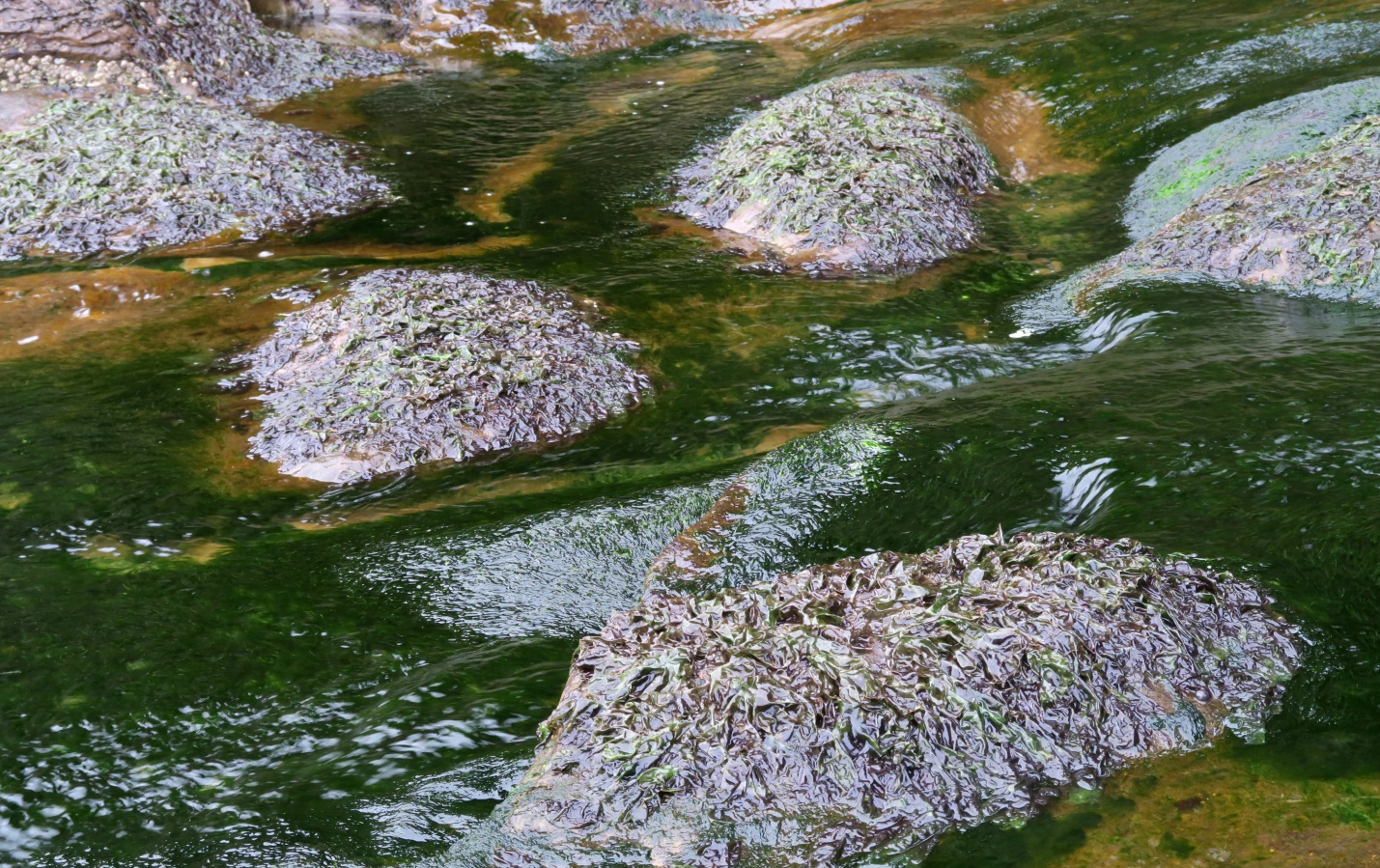
Figure 1: The general area of our Whispering interaction is pictured here. Pyropia fallax is the bladed multicolored seaweed that is profusely covering the topmost surfaces of the rocks. A seasonal freshwater stream runs through the area and the green algae, Ulothrix flacca makes its home there. French Beach, Juan de Fuca Strait, B.C., Canada. February 5, 2024. Photo ID 27629 ©Seaweedwhisperings.com
Person 1:
In my field notebook I wrote the names of the two seaweeds we’d be ‘listening’ to today, so I put:
Ulothrix flacca, then Pyropia fallax. And then I also wrote this one point that initially I crossed out but which might still be valid – “seems to be pair”.
The next morning, when I saw the photograph Person 2 showed me that was taken by a phycologist from Japan (which pictured these same two seaweeds growing side-by-side in a very similar way to what we saw at French Beach), that brought this thought back – “they seem to be a pair”.
About Pyropia fallax, in specific, I also noted the following:
Showy, exhibiting an array of red, purple and green coloration.
Prefers growing on round slippery boulders where little else can attach.
Today my first thought on seeing Pyropa fallax was “green with envy”.
Appears lush, vibrant, perky.
Unbothered and perhaps not very aware of what’s around it. Or perhaps it needs time to analyze / process what it detects.
Maybe the “green with envy” means it is inwardly lacking contentment, wishing for something it isn’t.
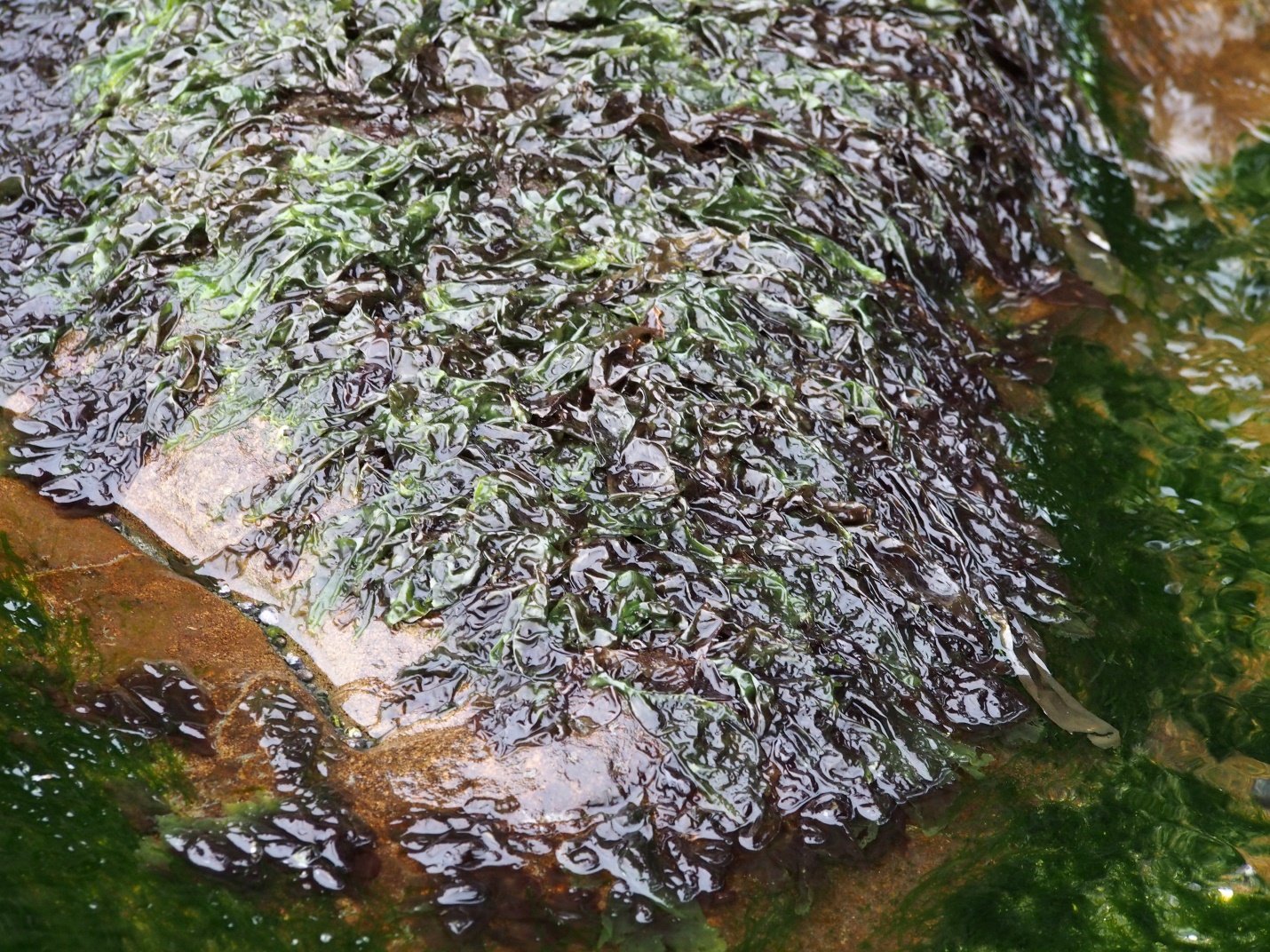
Figure 2: A closer view of Pyropia fallax shows the multiple colors and ridges and valleys of the folding frond-like blades, however knowing just where one ends and another one begins is quite indiscernible. Some blades of the Pyropia are dipping into the pooling water, but they don’t flourish there like the neighboring green alga does. French Beach, Juan de Fuca Strait, B.C., Canada. February 5, 2024. Photo ID 27630 ©Seaweedwhisperings.com
Person 2:
In this place where fresh water runs down from the forest and pours over the sandstone rock shelf, there is a special high-intertidal area. What I first notice today is the sound. I hear fresh water burbling over the rocks in a constant gentle chatter of notes. And I hear rhythmic ocean swells crashing to the timing of the ocean’s pulse.
Two prominent sounds.
Two notable influences.
Two obvious seaweeds living here.
Let’s see if they both will ‘whisper’ to us. It seems almost ‘wrong’ to separate them or only listen to one of them.
Of these two seaweeds, one is a green algae, and it is named Ulothrix flacca, and the other one is a red algae; it is called Pyropia fallax.
The green seaweed loves growing in the slightly deeper crevices and pools on the rock shelf, whereas Pyropia fallax has a different home. Just a few centimeters of elevation higher on the protruding rock mounds or ledges is where Pyropia likes to grow. In many places here it has completely covered the tops of these rock surfaces in a shining, wrinkled, and multi-colored algal profusion. I almost called it an “algal carpet”, except carpets are made to be walked on, and this algae gives a look that says “Warning, slippery surface – Keep off!”
There are many aspects to this Pyropia that make it a bit confusing..., no, the better word is enigmatic – as in difficult to understand, puzzling even mysterious.
First of all is the shape – without deliberately separating out a single blade it is really hard to know what the shape of this seaweed truly is. It is also impossible to know by visual inspection alone how many individual blades of this seaweed are growing on a single rock surface.
Then there is the issue of texture; the margins are ruffled and so the blade never lays flat anywhere and this creates a complex surface topography that is full of light and dark contrast – it reflects light in the peaks of the ridges and it holds it in the shaded valleys of its folds.
Thirdly there is the color aspect. The seaweed looks multicolored, and indeed it ranges from deep wine red to pale rose-brown grey and from lime green to pale green grey.
Again it is not easy to understand this seaweed – is it a red? Is it a green? Is it everything?
The coloration today is a bit different than we’ve seen at other observations. Mainly it is the amount of green and the tone of green; today it is almost lime green in places and there is really quite a bit more of the green in proportion to red. More typically we have seen this Pyropia from the distance looking like a rich, deep wine red mass. At those times, too, even though “red” is what catches the eye, if you examine each blade, you will find that the red is prominent at the tips and margins of the blade and that this red fades subtly to green towards the center of the blade. Today this green is distinct and brighter, more contrasting – possibly a result of very recent sub-freezing temperatures, or some other factor.
The overall effect of all these physical traits is to transform the group of individual blades into an enigmatic larger whole. Is this enigmatic and mysterious outward persona intentional or simply a natural result of a complex and varied energy? Maybe we can find out...?
In many places here, there are rocky prominences that look ever so much like “islands of Pyropia” floating among a sea of moving fresh water with its population of green algae. Pondering this a moment it seemed to me that the Pyropia could feel “surrounded” by “others”. And how different do those ‘others’ seem? Could they even feel like enemies..., most certainly they are competitors, as they can grow more strongly where Pyropia fallax does more poorly?
The result here, though, is that there are populations of Pyropia that are isolated to themselves, and that they are completely surrounded by strangers, by ‘different’ others, by ones Pyropia doesn’t understand. And in turn, those others don’t understand Pyropia either.
Pyropia does live just that bit “higher up” in the topography. Does that make them seem arrogant or unavailable to others? Regardless, Pyropia does dip in, and tries to reach down and around to the other zones around it..., but often does not seem to fare well in those efforts. So maybe it feels OK to be isolated unto itself, as there are all those many folds, and ruffles and colors with which to expand their view of, and their experience of, life.
But there is the feeling that they are not totally OK with the sense that those others around them find the ‘Pyropia enigma’ too much to contemplate or to really be bothered with. Possibly Pyropia can even be a bit intimidating to others. The result, however, seems to be the same – Pyropia can be shunned, or at least certainly not socially accessible enough to be of interest to the ‘others’.
So how is it to know this, Pyropia – that you seem ‘not understandable’ to others and therefore you are not ‘liked’ and even shied away from? Pyropia can’t see what it is that is so enigmatic about them; they are simply being themselves. And somehow that makes them ‘too different’, and if you are too different, well clearly then you are unpopular and lacking in friends.
What to do about that? Do they try to “explain” that which they have no words to explain, or do they accept the isolation and carry on with what interests them. Pyropia, it seems, carries on, and does so with an abundance of energy for those interests, too.
However, there remains within Pyropia a wistful kind of desire for something else – possibly we could term that ‘desire’ as a chance to understand others and to be understood themselves.
It is interesting that I felt it would be good to ‘listen’ to both Pyropia fallax and its neighbor herprominencese, Ulothrix flacca, today. There is something significant for Pyropia fallax that is more easily seen in this ‘context’, and that is that no matter how hard they try, there can be an isolated type of feeling to their energy. Even though they are side by side with others, they are not truly a part of the group.
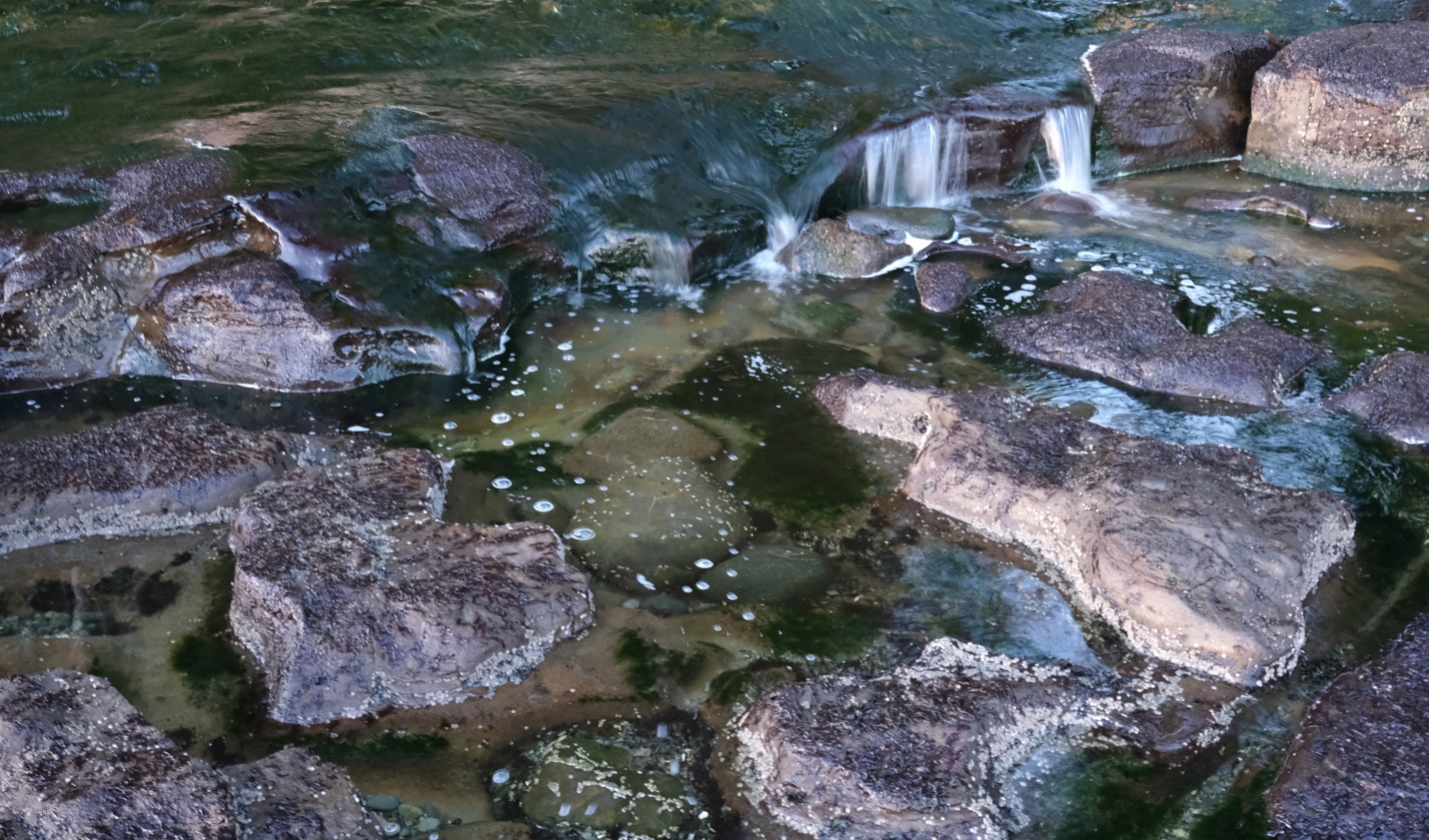
Figure 3: On another year, a visit to this same site shows the Pyropia fallax proliferation on the rock tops (in combo with the dark green Ulothrix flacca) in its deeper red toned look. It coats and gives texture to the rocks and is impossibly slippery to walk upon. French Beach, Juan de Fuca Strait, B.C., Canada. January 18, 2023. Photo ID 27631 ©Seaweedwhisperings.com
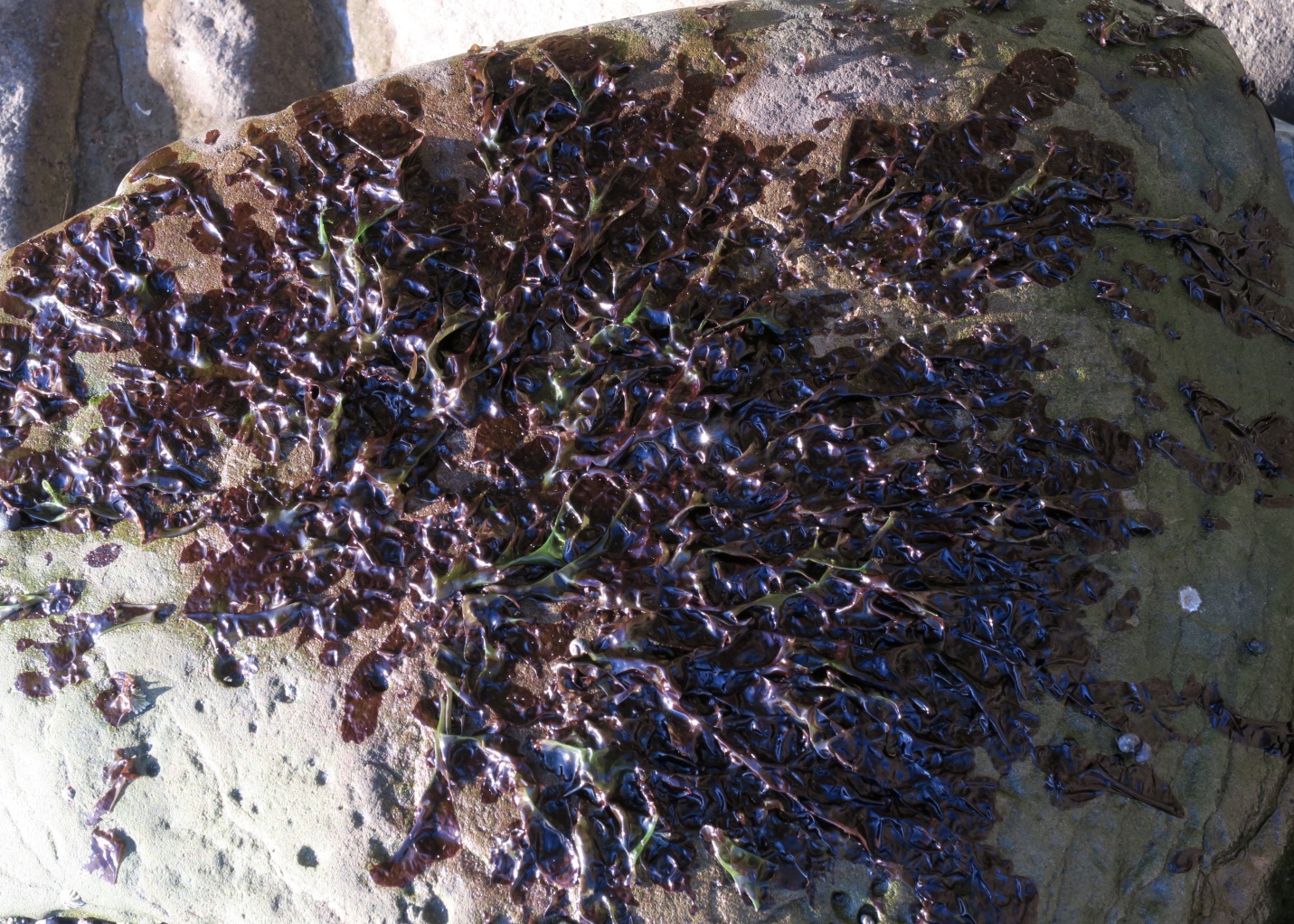
Figure 4: Looking up closer and a bit earlier in the season, this image depicts some of the “showy” aspect of this seaweed. This photo was taken earlier in the winter/spring season, on January 6, making it only 2 weeks past the winter solstice. Here the colors and ruffles and light reflecting qualities of False Laver are evident. The position, too, is typical; Pyropia fallax loves to grow on top of medium and large boulders. It is not timid or shy and does not hide, but rather seems to enjoy the view and the exposure. The image below gives a larger overview of this trait. French Beach, Juan de Fuca Strait, B.C., Canada. January 6, 2024. Photo ID 27632 ©Seaweedwhisperings.com
Discussion:
This seaweed, compared to others nearby, takes to the tops of the rocks and prominences and projections. It likes it there! Certainly there they have a better view. It also sets them somewhat above and separate from others. Why do they seek that separation? Is it a protection? A defense?
Person one caught the concept of “green with envy” for this alga. And also that it is showy – showy with color, lush, vibrant and perky. These sound like traits that could be envied in and of themselves. But they are all physical and external. So the “envy” Pyropia experiences most likely relates to unfulfilled inner wishes..., to being unable to find contentment within.
Is it a red? Is it a green? Then we thought: “Is a red and a green and everything between?” This may be where Pyropia fallax is sure to find no path to contentment. It cannot “be everything”, all colors, all textures, all light, or all dark, at least not at the same moment in time. There is a variety to what interests Pyropia, to what it considers and explores and engages in, that can take them in many directions. One day they’re all about “red” and another day they’re all about “lime green” – and if you asked them which one they are, well, they’d not willingly choose one over the other. Their confidence in these differing ways of being while they are in them, and the resulting inconsistency of willingly changing them up, is understandably tricky for others to relate to very comfortably.
Pyropia’s isolation and seeming paucity of friendships and connections to others was visibly clear at our Whispering location. Pondering this a bit further we saw that as Pyropia keeps trying out many things, many colors, many ups and downs, many perspectives and views out around them, they also do not find it often possible to truly attach loyalty to one way over another. To form alliances or join groups, they perhaps lack the ability to genuinely “sign up” for what might seem too limiting or restrictive an ideology. One gang believes one thing, another gang a different thing; Pyropia “changes its colors” too often, or perhaps values the possibility to change its colors when it so chooses, to qualify as a member in good standing.
Perhaps, too, Pyropia can give up a bit too easily. If they meet with opposition socially, even moderately, do they too swiftly revert to the familiarity and solitude of their own company? They may have no real understanding of the possibilities inherent in the phrase “strangers are friends we haven’t met yet”. They are suspicious enough, often learned from past personal experience, to even believe that strangers could prove to be enemies, and so they are overly cautious. That caution contributes to their choice to remain just a small step above and physically separated so that they are indeed somewhat protected from harm, yet they are also left with a subtle longing for the love and support they sense can come with the group affiliations that they often find difficult to truly join in on.
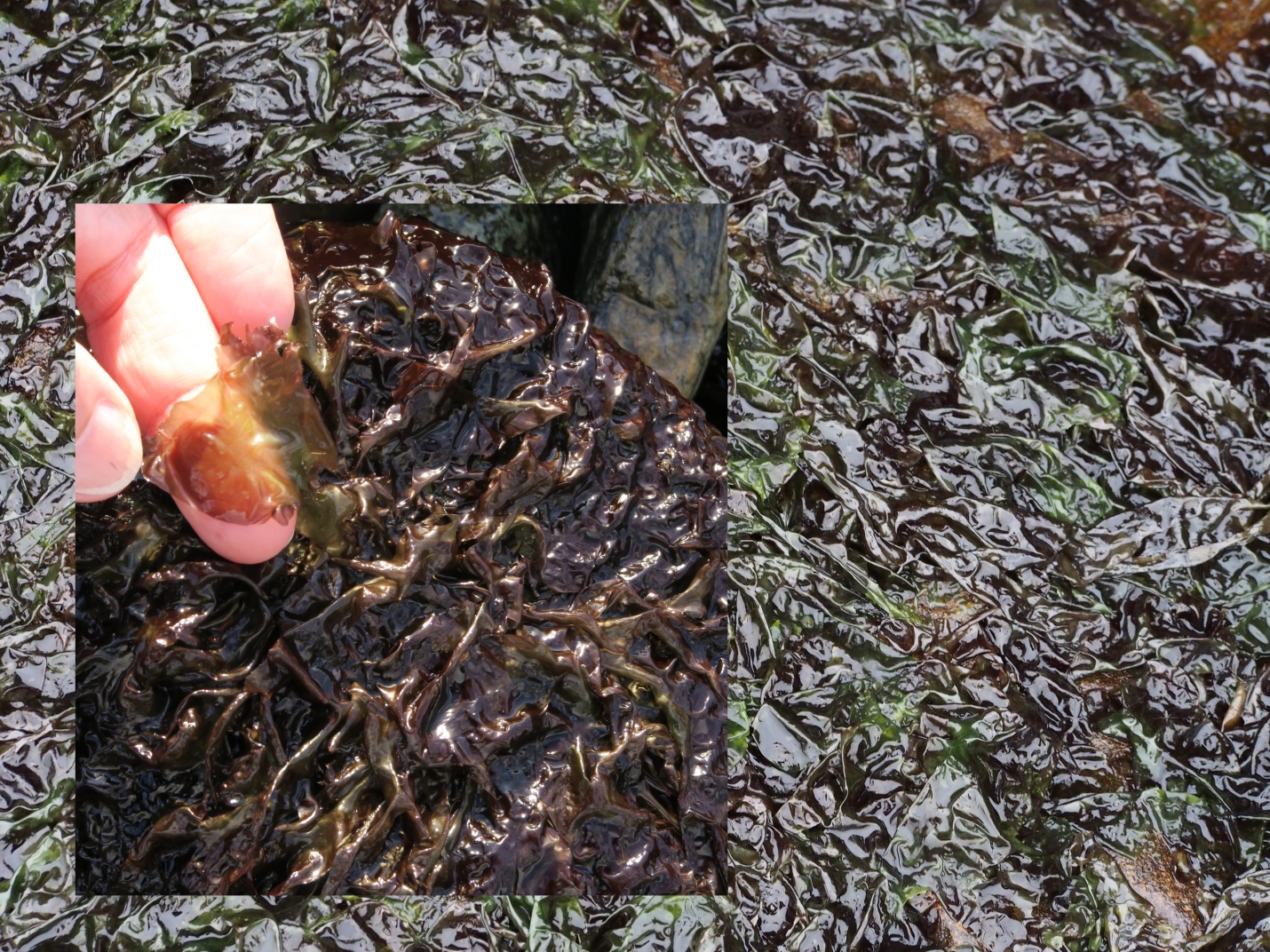
Figure 5: The small inset image shows a single thallus held up to reveal the red fading to green in the middle of the blade – a coloration feature that helps identify this Pyropia in the field. The background photo was taken at a nearby location several weeks later in the season and following several days & nights of subfreezing temperatures. In the intertidal zone where this seaweed is growing, frost would have had an impact and possibly influenced how much “green” is revealed. Jordan River, Juan de Fuca Strait, B.C., Canada. December 23, 2023 (inset); French Beach, Juan de Fuca Strait, B.C., Canada. February 5, 2024. (background) Photo ID 27633 ©Seaweedwhisperings.com
Biology & Natural History Information:
Description:
A Pyropia species of northern waters, this may be the most common species in Alaska. Thallus is a reddish-brown blade that can grow to ~50 cm (20 in) long. It is elongate in overall shape and has ruffled margins. The red pigmentation subtly fades to green towards the center of the thallus. Because the seaweed is so ruffled and grows in groupings, the green is not usually obvious from a distant view. Like other members of this genus, Pyropia fallax blades are only one cell layer thick. This gives them a limp or draping texture, and also one that moves easily with currents. It will dry and rehydrate easily, changing from crisp sheets to fluid ones as conditions dictate. The margins of the blades become pale red when female reproductive cells are fertilized. Male reproductive structures are found in white patches or streaks extending throughout the blade.
Habitat:
This seaweed can be found from the high to lower mid-intertidal zone, typically growing on rocks. It is found in areas ranging from protected to exposed shores and can be associated with sand.
North Pacific Distribution:
Aleutian Islands, Alaska, and along the coastline of British Columbia, through to northern Washington.
Remarks:
This species is similar to Pyropia abbottiae, however the latter has darker reproductive patches, and Pyropia fallax can be found higher in the intertidal zone. P. abbottiae is more commonly a species of the mid to low intertidal. The genus name, Pyropia, derives from the Greek meaning ‘fire’; this refers to the color of some of the species. This species, like many others in its genus, is edible and nutritious; it remains an important food source for many coastal First Nations people.
Classification:
Phylum: Rhodophyta
Class: Bangiophyceae
Order: Bangiales
Family: Bagiaceae
Genus: Pyropia
Species: Pyropia fallax (S.C.Lindstrom & K.M.Cole) S.C.Lindstrom 2011
Former name(s): Porphyra fallax S.C.Lindstron & K.M.Cole 1990
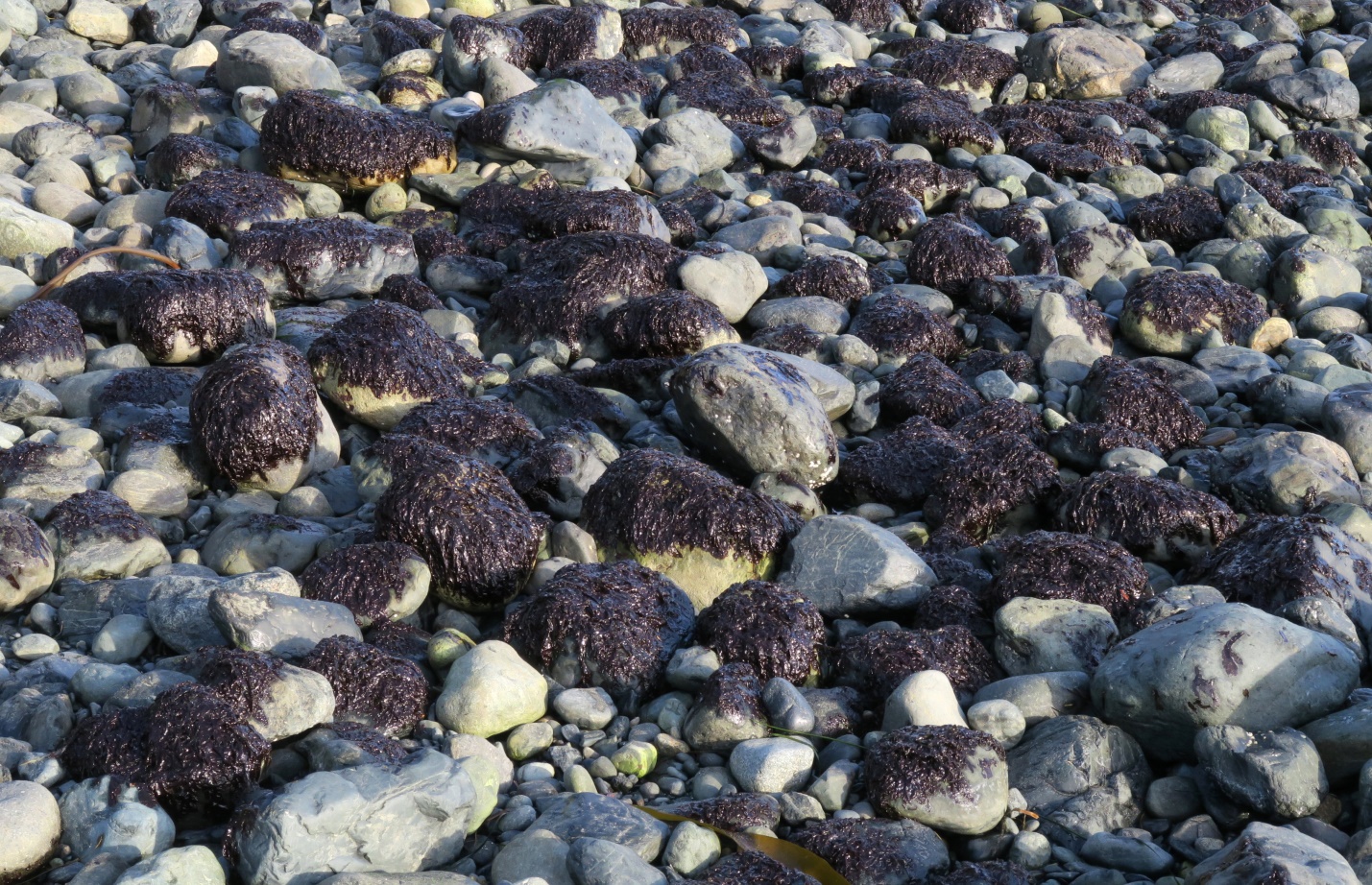
Figure 6: Here the medium sized cobbles / boulders are adorned with Pyropia fallax. At this place, the high mid-intertidal zone, and at this time, winter/spring growing season, this seaweed is in its prime. Jordan River, Juan de Fuca Strait, B.C., Canada. January 6, 2024. Photo ID 27634 ©Seaweedwhisperings.com
![]()